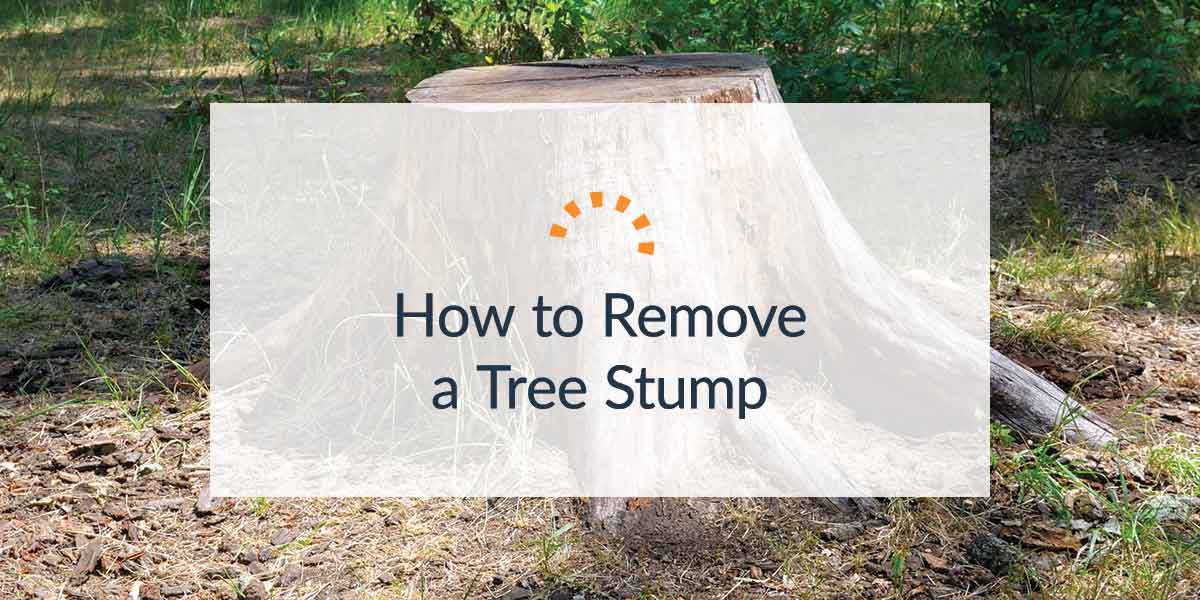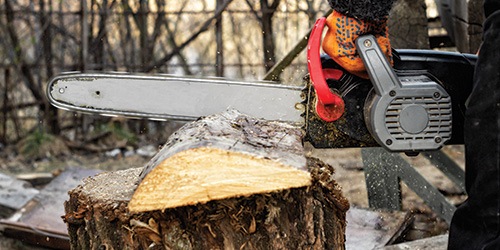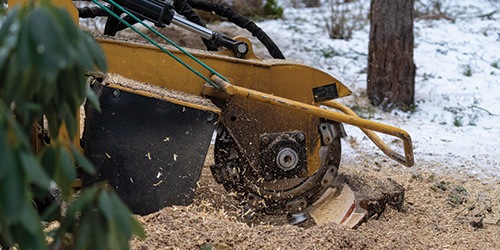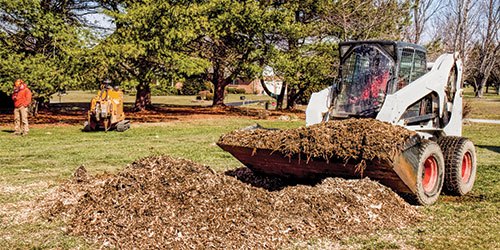
Removing a tree stump can be one of the hardest property maintenance projects to take on, but in many cases, it’s necessary. You might be tempted to just cover the stump with dirt if you’re in a hurry, but a tree stump and root systems can cause long-term damage to your property. Dying tree stumps may also attract pests, such as termites. If the tree stump stays alive and manages to sprout, weeds can grow out of control in the area.
People will often call professionals to get the job done, but if you enjoy taking a DIY approach to your yard work, there are plenty of stump removal techniques you can use. Here are three reliable methods for removing a stump. The first method, using a chainsaw and stump grinder, is a quick and direct method if you need to remove your tree stump ASAP. The second option involves applying potassium nitrate to kill the stump before breaking it apart, while the other calls for burning the stump using conventional lighter fluid. Choose one of the most popular stump removal methods below based on the time and equipment you have available.

Use a chainsaw and stump grinder if you don’t want to expose your land to chemicals, or when you need a quick and simple hands-on solution. Keep in mind that you need experience with using a chainsaw. You’ll also need protective gear to safely remove a tree stump with this method. Stump grinders are expensive, so consider renting from your local home improvement store.
Here are the essentials for this tree stump removal technique. If you don’t own these items, you can reach out to local businesses to rent them.
Stump Removal Tools for Chainsaw Method |
|
|
Tools |
Supplies |
|
|
Some DIY chainsaw users might feel confident in gardening gloves and goggles, but wearing the right gear is always best when using a chainsaw to cut a tree stump. A helmet, ear defenders, and chainsaw-resistant clothing are all recommended. Anyone assisting you while you use the chainsaw should also be wearing this gear.
Before you start, double-check there aren’t any obstacles in the work area, such as leftover tree branches or dirt crowding the stump. Use a shovel to expose the tree stump and allow the chainsaw easy access. You want to avoid letting your chainsaw touch dirt.
Begin by creating deep cuts around the edge of the tree stump as close to the ground as possible. Don’t get too close, however, since dirt can damage your chainsaw. Remember that the edges of the stump are more difficult to cut through than the middle and can take some effort when starting a new cut.
Continue widening the cuts to create wedge-shaped indents around the whole stump. Slowly cut deeper until the whole stump has been severed. Tap the stump with your shovel to gauge how loose it is, and once it’s ready to be moved, use the shovel or your hands to tip over the stump.

Now that the upper part of the stump is gone, it’s time to handle what’s left in the ground using a stump grinder. This tool can often be rented from local tree service companies. Be sure to keep your safety gear on during this step, and keep any rocks clear of the stump.
When you’re ready, wheel the grinder up to the stump and start it up. Gently grind away at the stump. Going slow and steady is important. Keep a lookout for roots while working, since you’ll want to grind them away if possible.
With your stump gone, you’ll have a small pit full of sawdust in its place. You can clear the sawdust and cover it over with topsoil.

If the first method doesn’t fit your situation, burning a tree stump can be just as effective. Before you start this process, make sure that you’re allowed to burn a tree stump in your town or city. Look up local guidelines on burning yard waste and call municipal authorities when in doubt.
Unlike the first method, you won’t need to rent a stump grinder. Many of these items might already be sitting in your garage.
|
Stump Removal Tools for Burning Method |
|
|
Tools |
Supplies |
|
|
Safety is very important when using flammable chemicals in your yard. Keep flammable items and other plants away from the tree stump before you start burning it. Once you start the fire, don’t leave it unattended. For maximum protection, you should wear flame retardant gloves during the process. Also, make sure that your hair and your clothes stay clear of the flames.
First, use a shovel to dig away anything near the stump and expose the roots. Next, drill holes into the stump. You’ll need multiple holes on the sides and a large hole down the middle of the stump. Holes all over the stump will help the kerosene to soak thoroughly for a good burn.
Pour kerosene into the holes. Don’t worry about completely soaking the stump. Just make sure that the kerosene travels into the holes you drilled. To speed up the fire, add a rag soaked in kerosene to the hole in the middle of the stump.
Pro-Tip: Kerosene is a good halfway point between gasoline, which would create a roaring fire, and other chemicals which might burn out quickly.
If you want to burn a tree stump with charcoal, you can place the briquettes on top of the kerosene-soaked stump, then add more kerosene on top and light the fire. The charcoal will help regulate the flames and burn the stump quickly, but you need to keep the charcoal contained. Use an oil drum with the bottom cut out, or a similar fire-proof cylinder, to enclose the stump as it burns.
Light the kerosene-soaked rag with a candle lighter and monitor the fire as it spreads through the stump. Don’t leave the fire unattended. Keep the fire going with kindling or small twigs as needed. The flame needs air to keep burning, so if you want the fire to grow, you can use a fan or even a leaf blower to push air into the holes.
Removing a tree stump with potassium nitrate (also known as saltpeter) will take longer than the previous methods, but is also the least labor-intensive. Potassium nitrate is available online as well as in home and garden stores. Application is simple and makes removal of the tree stump much easier.
Pro-Tip: Chemicals are only effective on stumps that have been sitting for over a year. Fresh stumps will not be affected enough by the chemicals, because they haven’t had time to fully dry out. To remove a fresh stump, a chainsaw and grinder is usually the best option.
You’ll likely need to make a trip to the store for the potassium nitrate, but the other tools may already be in your tool shed or garage.
|
Stump Removal Tools for Potassium Nitrate Method |
|
|
Tools |
Supplies |
|
|
As in the burning method above, you should start by drilling multiple holes in the tree stump. Use the longest drill bit you have to create deep holes in the stump. Aim for holes with at least a half-inch diameter.
Start by adding the chemicals into the drill holes, then pour in hot water without letting the potassium nitrate completely spill out. Rather than immediately lighting the chemicals, like in the kerosene option, you’ll need to wait and let the chemicals take effect over the course of three weeks, or longer if the stump is very large. During this time, the stump will decompose and become much easier to destroy.
Once the stump has had weeks to rot, it can be easily broken apart with an axe. As always, wear protective equipment while chopping up the stump. If you’re struggling to break apart the stump, consider adding more potassium nitrate, followed by hot water, and letting it sit for another week or two.
Using Epsom salt instead of potassium nitrate is an eco-friendly way to rot your tree stump before removal. If Epsom salt is more readily available to you, you can use it in the same way as described for the potassium nitrate. Keep in mind that the effects may not be as potent and this option takes more time. You should also cover the tree stump to let the salt work without being disturbed by rain or snow.

If you’re interested in planting a new tree where the stump was, consider planting the tree just a few feet away. Putting a new sapling right where the stump was removed might deprive it of nutrients, since the old tree had access to the soil for a long time.
Yes, but it is not recommended. The roots can do a lot of damage to nearby structures. If the stump remains alive, it can cause problems like weeds or attract pests like termites.
A yard waste dumpster is a convenient disposal method for tree stumps. Please note that notes or restrictions may apply in your market. Give us a call and we’ll recommend the best option for you.
Epsom salt is one of the most environmentally friendly methods available. This option is more time-consuming than cutting the stump by hand, but it naturally rots and softens the tree stump for easy removal.
Now that your tree stump is gone, what will you do with the new space in the yard? You could build a new shed, porch or path in its place, or plant a new tree as mentioned above. You’ve cleared the way for what’s next – now it’s your time to be creative and reshape your property.
As a final note, don’t be afraid to call the experts for help with removing a stump. You can also refer to our yard waste disposal guide for more help on what to do with the waste after you remove a tree stump.